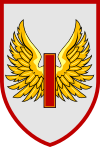1(F) Squadron
| No. 1 Squadron RAF | |
|---|---|

|
|
| Active | 1 April 1911 – 13 May 1912 (RE) 13 May 1912 – 1 April 1918 (RFC) 1 April 1918 – 1 November 1926 (RAF) 1 February 1927 – 28 January 2011 15 September 2012 – present |
| Country | United Kingdom |
| Branch | Royal Air Force |
| Type | Flying squadron |
| Role | Multi–role combat |
| Part of | No. 1 Group RAF |
| Home station | RAF Lossiemouth |
| Motto(s) |
In omnibus princeps (Latin for First in all things) |
| Aircraft | Eurofighter Typhoon FGR4 |
| Battle honours |
|
| Insignia | |
| Squadron tail badge |  |
| Squadron badge heraldry | A winged numeral "1". Approved by King Edward VIII in July 1936 as the authorised version of a badge which had originated during the First World War. |
| Post 1950 squadron roundel | |
| Squadron Codes |
NA (Nov 1938 – Sep 1939) JX (Sep 1939 – Apr 1951) FA–FZ (Present) |
No. 1 (F) Squadron is a squadron of the Royal Air Force. It was the first squadron to fly a VTOL aircraft. It currently operates Eurofighter Typhoon aircraft from RAF Lossiemouth.
The squadron motto, In omnibus princeps ("First in all things") reflects the squadron's status as the RAF's oldest unit, having been involved in almost every major British military operation from the First World War to the present time. These include the Second World War, Suez Crisis, Falklands War, Gulf War, Kosovo War, and Operation Telic (Iraq).
No. 1 Squadron's origins go back to 1878 when its predecessor, No. 1 Balloon Company, was formed at the Royal Arsenal, Woolwich as part of the Balloon Section. On 1 April 1911 the Air Battalion of the Royal Engineers was created. The battalion initially consisted of two companies, with No. 1 Company, Air Battalion taking responsibility for lighter than air flying. The first Officer Commanding was Captain E. M. Maitland.
On 13 May 1912, with the establishment of the Royal Flying Corps, No. 1 Company of the Air Battalion was redesignated No. 1 Squadron, Royal Flying Corps. No. 1 Squadron was one of the original three Royal Flying Corps squadrons. Maitland continued as the new squadron's Officer Commanding and he was promoted to major several days after the establishment of the squadron. It retained the airships Beta and Gamma, adding Delta and Eta, as well as kites and a few spherical balloons. However, in October 1913 a sudden decision was made to transfer all the airships to the Naval Wing of the RFC (which became the Royal Naval Air Service by Admiralty dictat, not Cabinet decision, on 1 July 1914). While retaining kites 1 Squadron was reorganised as an 'aircraft park' for the British Expeditionary Force.
...
Wikipedia
